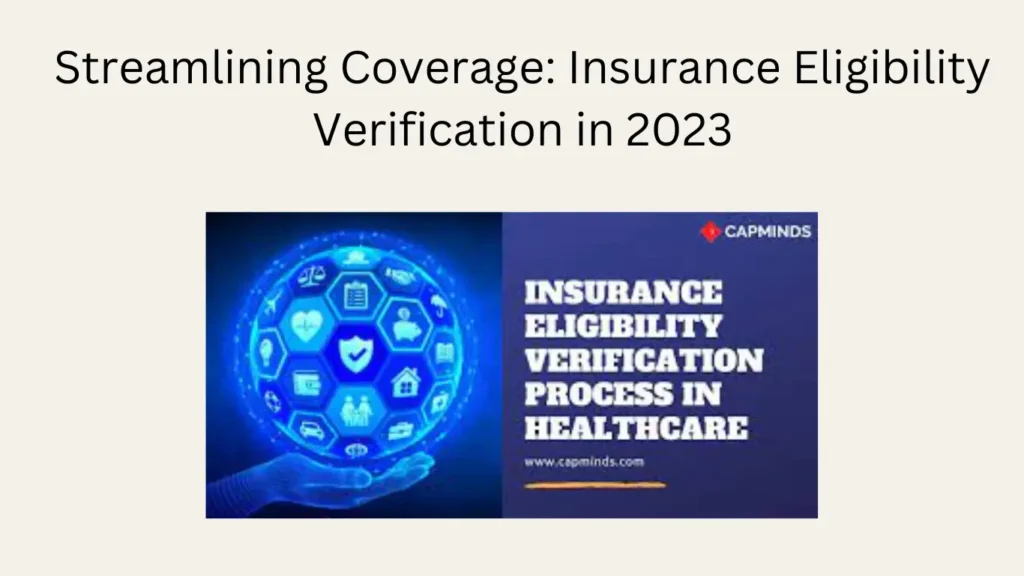In the ever-evolving landscape of healthcare, one of the critical components that ensures smooth operations for both providers and patients is insurance eligibility verification. As we step into 2023, the need for a streamlined and efficient verification process has never been more pronounced. This blog post explores the challenges faced by the healthcare industry in this regard and highlights the technological advancements and strategies that are shaping insurance eligibility verification in the current year.
The Challenge: Navigating Complexities in Insurance Eligibility
Insurance eligibility verification is a crucial aspect of healthcare operations, involving the confirmation of a patient’s insurance coverage and the assessment of their benefit extent. This process is indispensable for healthcare providers, as it helps them steer clear of financial setbacks and ensures that patients receive timely and necessary care, minimizing unnecessary delays.
However, the intricacies of verifying insurance eligibility often introduce complexities into the healthcare landscape. The multitude of insurance plans, each governed by its own set of rules, coverages, and eligibility criteria, contributes to a challenging and time-consuming verification process. This complexity not only consumes valuable time but also heightens the risk of administrative errors, claim denials, and increased costs for both healthcare providers and patients.
Navigating this intricate terrain demands a skilled workforce, making careers in healthcare administration and insurance verification more significant than ever. Professionals in these roles play a pivotal part in ensuring the seamless functioning of healthcare facilities. Their expertise is instrumental in deciphering the nuances of various insurance plans, staying abreast of ever-changing regulations, and efficiently managing the verification process.
In essence, the intersection of insurance eligibility verification and careers in healthcare administration underscores the importance of a knowledgeable and skilled workforce. As the healthcare landscape evolves, so too must the professionals involved in the verification process, adapting to new technologies, regulations, and strategies to maintain the delicate balance between financial responsibility and optimal patient care.
Technological Advancements: A Beacon of Efficiency
In response to these challenges, the healthcare industry is embracing technological advancements to streamline insurance eligibility verification. Artificial Intelligence (AI) and machine learning algorithms are being deployed to analyze vast amounts of data and provide real-time insights into a patient’s insurance coverage.
Automated systems equipped with these technologies can quickly and accurately verify eligibility, reducing the burden on administrative staff and minimizing the likelihood of errors. This not only accelerates the verification process but also enhances the overall efficiency of healthcare operations.
Real-Time Data Integration: A Game-Changer
One of the key developments in insurance eligibility verification is the integration of real-time data. Instead of relying on periodic updates or manual data entry, healthcare providers now have access to dynamic, up-to-the-minute information about a patient’s insurance status.
This real-time data integration ensures that providers are working with the most current information, reducing the chances of claim denials due to outdated eligibility data. It also allows for proactive management of patient expectations, as providers can communicate more accurately about potential out-of-pocket costs and coverage limitations.
Enhanced Patient Experience
Streamlining insurance eligibility verification isn’t just about operational efficiency—it’s also about improving the overall patient experience. By reducing wait times, minimizing paperwork, and providing accurate information upfront, healthcare providers can enhance patient satisfaction and build trust.
Patients benefit from a more transparent and predictable financial experience, knowing exactly what their insurance covers and what they may need to pay out of pocket. This improved communication fosters a positive relationship between patients and healthcare providers.
The Road Ahead: Continuous Innovation
As we move further into 2023, the focus on streamlining insurance eligibility verification is set to continue. Continuous innovation in AI, machine learning, and data analytics will pave the way for even more sophisticated and efficient verification processes.
The integration of blockchain technology, for example, holds promise in creating secure and transparent systems for sharing and verifying patient information across healthcare networks. Additionally, collaborative efforts between insurers, providers, and technology companies will be crucial in developing standardized approaches that simplify the overall landscape of insurance eligibility.
In conclusion, the year 2023 marks a pivotal moment in the quest for a more efficient and effective insurance eligibility verification process. With technological advancements and a commitment to improving patient experiences, the healthcare industry is on the path to streamlining coverage and ensuring that the road to care is as smooth as possible for both providers and patients alike.
FAQs:
Q: Why is insurance eligibility verification important in healthcare?
A: Insurance eligibility verification ensures that healthcare providers can offer timely and accurate care while avoiding financial setbacks and administrative complications.
Q: How does technology streamline the insurance eligibility verification process?
A: Technologies like AI and real-time data integration automate the verification process, reducing errors, minimizing delays, and enhancing overall operational efficiency.
Q: What benefits do patients gain from streamlined insurance eligibility verification?
A: Patients experience shorter wait times, less paperwork, and improved transparency regarding their coverage, leading to a more positive and satisfying healthcare journey.
Q: Are there potential challenges in implementing real-time data integration for insurance verification?
A: While challenges exist, such as data security and system integration, ongoing technological advancements and best practices aim to address and overcome these obstacles.
Q: What does the future hold for insurance eligibility verification in healthcare?
A: The future involves continuous innovation, including the integration of blockchain technology, collaborative efforts for standardization, and a commitment to creating more seamless and transparent processes in healthcare.
